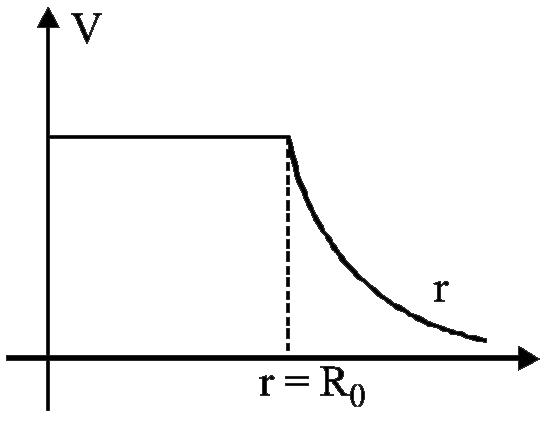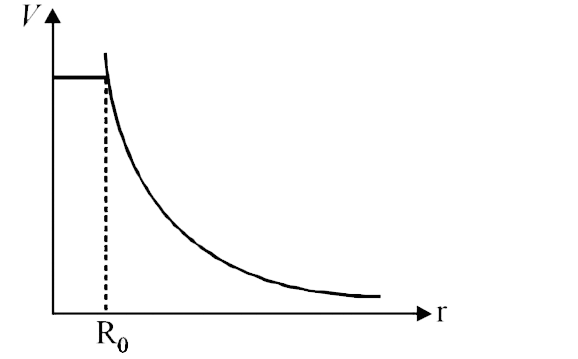The electrostatic potential (ϕr) of a spherical symmetric system , kept at origin is shown in the adjacent figure, and given as
ϕe=q4πɛ0r(r≥Ro)
ϕe=q4πɛ0Ro(r≤R0)

Which of the following option s in //are correct ?
For spherical region (r≤R0), total electrostatic energy stored is zero.
Within r=2R0 total charge is q.
There will be no charge anywhere except at r=R0.
Electric field is discontinuous at r=R0.
The correct Answer is:A, B, C, D
Step by step video & image solution for The electrostatic potential (phi _r) of a spherical symmetric system , kept at origin is shown in the adjacent figure, and given as phi _e = q/( 4 pi varepsilon_0 r) (r ge R_o) phi _e = q/( 4 pi varepsilon_0 R_o) (r le R_0) Which of the following option s in //are correct ? by Physics experts to help you in doubts & scoring excellent marks in Class 12 exams.
Updated on:21/07/2023Topper's Solved these Questions
- ELECTRIC POTENTIALBOOK - RESNICK AND HALLIDAYCHAPTER - ELECTRIC POTENTIALEXERCISE - (PRACTICE QUESTIONS) Linked Comprehension
2 Videos
- ELECTRIC POTENTIALBOOK - RESNICK AND HALLIDAYCHAPTER - ELECTRIC POTENTIALEXERCISE - (PRACTICE QUESTIONS) Matrix-Match
4 Videos
- ELECTRIC POTENTIALBOOK - RESNICK AND HALLIDAYCHAPTER - ELECTRIC POTENTIALEXERCISE - (PRACTICE QUESTIONS) Single Correct Choice Type
21 Videos
- ELECTRIC CHARGES AND FIELDSBOOK - RESNICK AND HALLIDAYCHAPTER - ELECTRIC CHARGES AND FIELDSEXERCISE - Practice Questions (Integer Type )
3 Videos
- ELECTROMAGNETIC INDUCTIONBOOK - RESNICK AND HALLIDAYCHAPTER - ELECTROMAGNETIC INDUCTIONEXERCISE - PRACTICE QUESTIONS (Integer Type)
14 Videos
Similar Questions
The graph of a quadratic polynomial y=px2−qx+r is as shown in the adjacent figure, then (i)r2−4q<0 (ii)r2−4p<0 (iii) p+q>0 (iv) r−p−q>0
View SolutionFor spherical symmetrical charge distribution, variation of electric potential with distance from centre is given in diagram Given that : V=q4πε0R0 for r≤R0andV=q4πε0r for r≥R0
Then which option (s) are correct :
(1) Total charge within 2R0 is q
(2) Total electrosstatic energy for r≤R0 is non-zero
(3) At r=R0 electric field is discontinuous
(4) There will be no charge anywhere except at r<R0

View Solution
Knowledge Check
The electrostatic potential (ϕr) of a spherical symmetric system , kept at origin is shown in the adhacent figure, and given as
ϕe=q4πɛ0r(r≤Ro)
ϕe=q4πɛ0Ro(r≤R0)

Which of the following option s in //are correct ?AFor spherical region r≤R0 total electrostatic energy stored id zero .BWithin r=2R0, total charge is q.CThere will be no charge anywhere except at r=R0.DElectric field is discontinuous at r=R0.The electrostatic potential ϕr, of a spherical symmetrical system kept at origin, is shown in the adjacent figure, and given as
ϕr=q4πε0r(r≥R0)
ϕr=q4πε0R0(r≤R0)
Which of the following option is incorrect ?
 AFor spherical region r≤R0 total electrostatic energy stored is zeroBWith in r=2R0, total charge is q/2CThere will be no charge anywhere except at r = RDElectric field is discontinuous at r=R0
AFor spherical region r≤R0 total electrostatic energy stored is zeroBWith in r=2R0, total charge is q/2CThere will be no charge anywhere except at r = RDElectric field is discontinuous at r=R0A spherical symmetric charge system is centered at origin. Given, Electric potential
V=Q4πε0R0(r≤R0), V=Q4πε0r(r>R0)
 A(a) Within r=2R0 total enclosed net charge is QB(b) Electric field is discontinued at r=R0C(c) Charge is only present at r=R0D(d) Electrostatic energy is zero for r<R0
A(a) Within r=2R0 total enclosed net charge is QB(b) Electric field is discontinued at r=R0C(c) Charge is only present at r=R0D(d) Electrostatic energy is zero for r<R0
The electrostatic potential of a uniformly charged thin spherical shell of charge Q and radius R at a distance r from the centre
View SolutionIf Sr=√r+√r+√r+√......∞,r>0 then which the following is\are correct.
View SolutionTwo concentric spherical shells of radii R and 2R have charges Q and 2Q as shown in figure

Choose the correct optin (K=14πε0)
View SolutionA conducting sphere A of radius a, with charge Q, is placed concentrically inside a conducting shell B of radius b. B is earthed. C is the common center of AandB. Study the following statements.
(i) The potential at a distance r from C, where
a≤r≤b,is14πε0(qr)
(ii) The potential difference between AandB is
14πε0Q(1r−1B)
(iii) The potential at a distance r from C, where
a≤r≤b,is14πε0Q(1r−1B)
Which of the above statements are correct ?
 .
.
View SolutionGiven that 0 < p < q < r < s and p, q, r, s are integers, which of the following is the smallest?
View Solution
